Twenty-gauge high-performance lead loads can often outperform their commonly used 12-gauge counterparts-this has been shown vividly again and again. The most relevant example at hand is a load for wild pheasants. Often, the 12-gauge load selected happens to be the cheapest load available at the time, too often a promotional load with various sketches of birdies on the box. It will fall into the category of a 1.25-ounce 1330-fps load at an attractive price. Though the consumer might be told it is “ideal” for pheasants, things dont always work as described or as promised-one of the reasons for this publication.
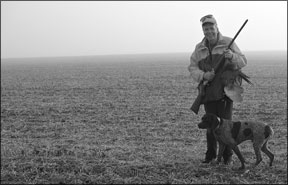
Used with quality loads, such as 1-5/16 ounce Winchester Supreme STH2035 shotshells or the Federal PFC258 3-inch shells, we recently proved once again that 20-gauge autoloaders like the guns tested below can produce patterns not just the equal of common 12-gauge loads, but verifiably superior.
In this shoot-off, we looked at three familiar names associated with gas-operated shotguns: Beretta, Browning, and Remington-to see what their blued-steel-and-walnut editions have to offer todays shotgunning enthusiasts. Our specific test products were the Beretta AL 391 Urika 2 Gold No. J39TB26 3-inch 20 Gauge, $1550; Browning Silver Hunter Twenty No. 011350605, $1079; and the Remington 1100 Premier Sporting Twenty No. 82846, $1385.
Our test ammunition included both 7/8 oz. Estate loads and Winchester Super-X Heavy Game Loads No. XU20H7 with 1 ounce of No. 7 1/2 shot-what we use as an everyday dove load along with Fiocchi 20HV75 shells. We also patterned with Federal Mag-Shok high-velocity lead 3-inch 1-5/16 ounce No. 5 shot (No. PFC258) and Winchester Supreme 1-5/16 ounce 3-inch shells with No. 5 shot (No. STH2035). We shot our patterns at 40 yards, the patterning all shot from bag and cradle. We also fired the guns extensively at the range and in the field to record what we liked and didnt like about the guns. Heres what we learned:
Beretta AL 391 Urika 2 Gold
No. J39TB26 3-inch 20 Gauge, $1550
The Urika 2 Gold weighed in 6.4 pounds. After significant, irritatingly long take-up and creep, the Urika trigger broke at 4.5 pounds, though it wasnt exceptionally consistent or repeatable. On any given pull, the actual break weight varied half a pound or more. We found it adequate, but we were still disappointed.
Out in the field, we function-tested the Beretta with the Winchester Super-X Heavy Game Loads. This gun features Berettas new “spinning toothed” gas piston that the company claims reduces “maintenance by 50%” and improves reliability by “over 40%.” We found this ad-brag to be wrong.
Though Beretta had assured us that its gas guns do not have to be shot in, the 391 was an instant jam-o-matic, failing to feed nine consecutive times. With the high-speed production of ammunition these days, it is of course a possibility that this Berettas inability to work was an ammo problem. To check, we fired a dozen shells from the very same case of ammo through the Browning Silver with zero malfunctions. Further, we fired a dozen shells from the same case through a Browning B-80 (made by Beretta), a Beretta 303, and finally a Browning A-5 20 Mag, all with no failures to cycle of any kind.
We continued on to the patterning board, and tested the Urika with our dove load and also gave it a good work out with Federal Mag-Shok high-velocity lead 3-inch 1-5/16 ounce No. 4s (No. PFC258) and Winchester Supreme 1-5/16 ounce 3-inch shells with No. 5 shot (No. STH2035). We found that the Beretta shot to the point of aim at 40 yards, and also gave us pattern percentages approximating the degrees of choke. The 1-5/16-ounce loads worked fine, but when we returned to the dove load, it jammed. We made more than a half-dozen calls and sent several e-mails to Berettas customer service department and other contacts in the company, but got no help in resolving the problem. Perhaps there was an easy fix
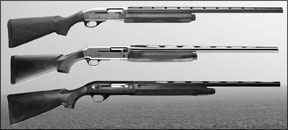
to the problem, but unlike Browning and Remington, which fixed the Silvers trigger and replaced the Remington barrel (both responses are detailed below) promptly, Beretta wasnt helpful.
Elsewhere, the Berettas hard buttpad offered no relief whatsoever from the jolting punishment dealt out with the heavy 3-inch shells. Even the 1-ounce loads wore our shooters out in short order.
Browning Silver Hunter Twenty
No. 011350605 3-inch 20 Gauge, $1079
Initially, we had concerns about the Silvers silver receiver, as prior chromed or polished-silver receivers have generated enough glare and shine in times past to be irritating. We were pleased to discover the receiver had a frosted, matte finish that didnt pull our eyes away from the matters at hand.
The Silver Hunter with 26-inch barrels weighed in at 6.75 pounds. Right out of the box, the Brownings trigger break was heavier than the entire gun at over 7.5 pounds-we shot it anyway, but the heavy trigger pulled us off clays, making smooth swinging and proper follow-through a chore. A quick phone call to Browning, and we were advised that Brownings trigger-weight spec runs 5 to 6 pounds on field guns, and theyd be happy to take of it for us (and for any customer, for that matter). Off went the Silver to Browning in Arnold, Missouri, where Browning turned it around the same day. It arrived back with a 5.75-pound trigger break. As we had previously noted in our Browning BPS 20-gauge test, even though the trigger was still heavy on the Lyman calibrated electronic trigger gauge, the wide trigger face of the Silver made the trigger seem substantially lighter than it really is. After a small amount of free travel (not the long, tortured creep of the Beretta), the Silver trigger broke crisply and consistently. We didnt even notice it when shooting and hunting.
We fed the Browning a variety of 20-gauge shells, including 7/8-ounce Estate loads, the 1-ounce Super-X loads that the Beretta couldnt handle, and the Federal and Winchester 1-5/16 ounce loads. The Browning eagerly gobbled up and properly ejected every shell we fed it, with no failures to feed, fire, or eject.
Our testers found the Browning to be a significantly softer shooter than the Beretta. The Browning weighed a few ounces more than the Beretta, and rather
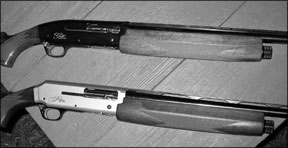
than rock-hard plastic came equipped with a fairly hard rubber butt pad. Nevertheless, we felt that the slight amount of weight and the pad did some good, but the gas action of the Browning just did a better job of lengthening the recoil pulse than the choppy Beretta attempt.
In any case, we found the Browning to be a joy to carry all day (we did just that working ditches for pheasants) and after a couple of limits of doves in the sack, we can only characterize the Silver as a very comfortable shooter.
There has been some confusion as to what the “Silver” action is and is not. In 20 gauge format, the Browning “Silver” is identical to recent 20 gauge “Golds,” retaining the speed-loading feature that sends the first shell inserted into the bottom of the receiver instantly into the chamber of the shotgun when the shotgun is empty, bolt-open condition. We used and appreciated this feature constantly, never having to take our eyes off the sky in the dove field, for example. It is equally handy on the skeet field or in the duck blind.
At the patterning board, we found that the factory improved Cylinder and Modified tubes gave generally consistent patterns with our Winchester 1-ounce No. 7-1/2 shot and both Federal and Winchester 1-5/16 oz. No. 5 shot loads, but the patterns turned splotchy and less even with the factory Full choke Invector Plus tube in all cases.
The wood of the Browning Silver was typical Browning Grade I walnut, darkly stained, with the forearm and buttstock evenly matched in color and tone. We found it attractive but plain, essentially straight-grained with very little character. Browning has done a very good job with its metalfinish work in recent years, and the Silver is no exception with its evenly applied, deep rich blue, which is more black than anything. As a whole, the Silver is muted but well finished. Though the Beretta has far better wood, it also has a plastic trigger guard. The Browning Silvers alloy trigger guard is more of what we like to see in field guns.
We really liked the handling of the Silver: it was quick without being whippy, light to carry yet easy on the shoulder. The entire gun has a nice, neutral balance to it as opposed to the slightly nose heavy feel of the Beretta. The Browning was balanced so well, in fact, we found it easy enough to shoulder, swing, and drop doves with-with one hand.
Remington 1100 Premier Sporting Twenty
No. 82846 2.75-inch 20 Gauge, $1385
We have been keeping our collective eyes on Remington for some time now, not really knowing what to expect, and, recently, we saw the expansion of Russian shotguns, Serbian rifles, and cheap Spanish muzzleloaders all widely circulated under the Remington brand. When Cerberus Capital Management sprung for $7.4
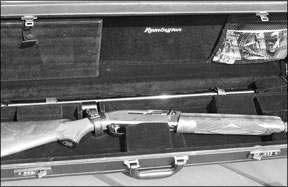
billion for an 80% stake in Chrysler, it made the Cerberus acquisitions of firearms-related companies appear trivial. That portfolio has grown substantially by now, with Bushmaster, DPMS, Marlin, NEF/H&R, and Cobb Manufacturing along with Remington under the same corporate umbrella.
So, what does all this buying and selling mean for the 1100-the seminal gas-operated autoloader? Introduced in 1963, by 1983 over 3,000,000 Remington 1100s had been produced. For this comparison, struggling as always for apples to apples-the original choice was the 1100 G3, a titanium and Teflon coated 11-87 designated as an 1100 for assumed marketability. Well, it seems the 1100 G3 20 gauge has vanished from current production. As puzzling as it sounds, apparently a blued-and-walnut 3-inch chambered autoloader cannot be had from Remington in 20 gauge at this juncture. So, the Premier Sporting 20 became our choice.
The Premier Sporting Case that houses the 1100 features combination locks and a plush interior that secures the disassembled 1100 elegantly and securely. With a drop-down drawer for choke tubes that snaps back into place, netting to the left for the owners manual and other sundry items, it is one of the most effective and practical gun cases in recent memory. We feel it is easily a $150 case; in fact we have seen several gun cases sell for more that arent nearly as competently done.
The 1100 likewise is an eye-catcher. Its wood is incredibly well figured, the fore-end and buttstock both full of spectacular grain, with the buttstock exhibiting “feather crotch.” The Remington had the best wood of the tested guns by far. This 1100 was impeccably finished, with expert wood-to-metal fit and a flawless gloss finish further extracting the stunning figure for the wood.
Though Remington specifications call out the 1100 Premier Sporting 20 as 7 pounds, they are way off track. If the catalog weight leads you to believe this version is a spritely, lithe 20 gauge-well, you will have been misled. Our 1100 tipped the scales at 8 pounds. It is the heavyweight of the tested twenties. Our 8-pound 1100 came equipped with a 6-pound trigger, a trigger with excessive take-up as an unwanted bonus. The actual break weight of the guns trigger was not bothersome, but the long take-up made it feel like we were pulling on the trigger for a mile before we got the intended result. The 1100s buttstock is finished off with a factory Limbsaver pad, not the new Remington SuperCell pad. Our testers think thats a very good thing, actually, because they believe the Limbsaver has proven to be a better pad than the Chinese SuperCell. The twin beads on the vent rib are set properly-the front bead is visible, the middle bead yours to utilize (or not) as you find appropriate.
The 28-inch barrel is the only length offered, and it comes with four extended nickel-plated choke tubes manufactured by Briley. They were not externally
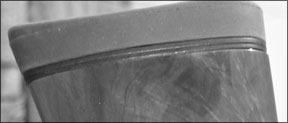
identifiable by markings, etchings, or notches. This is an oversight, requiring the shooter to either measure the exit diameter of the tube or remove it completely to identify it. In looking at the choke and barrel tolerances published by Remington, we were again negatively surprised. Remington “spec” is nominal bore diameter within a .004-inch spread, and their choke tubes are also within a .004-inch spread. What it means, that based on the four Sporting Clays tubes supplied (.612, .609, .606, .603 in. exit diameter) called Skeet, Improved Cylinder, Light Modified, and Modified-they could all have essentially the same constriction in use and throw the same pattern percentage or not. It is even more puzzling: when the chokes themselves are in .003 in. increments, but are allowed to be within .004 in. as allowable tolerance, the choke considered “more open” (IC) could actually be dimensionally tighter than the supposedly tighter Light Modified tube-and pattern with a higher percentage as well.
Measuring the supplied tubes, we discovered the “Skeet” to have an exit diameter of .616 in. (factory published spec .612), IC to be .596 in. (factory spec .609), Light Mod to be a .592 in. (factory spec. .606), and the Mod to be .587 inches exit diameter (factory spec .603).
If this sounds like a bewildering mess, it is only because it is. It is a tragic mistake to assume that factory screw chokes perform as marked; small wonder when they dont have dimensions anywhere near what they are presented as having. The factory Remington Modified was off a whopping .016 inch-that is more additional constriction than it is published as having (.014 in.) in the first place. Bottom line: If you dont pattern your shotgun, you are just shooting blind.
Still dazzled by the striking good looks of the 1100 Premier, it was off to the range, where we were met with more surprises.
The Remington 1100 Premier ostensibly fit most all of our shooters reasonably well, with its short stock and thin comb. It was easy to obtain a proper sight picture. But the Remington shot nowhere near point of aim, making squeaky clean complete misses a certainty. Puzzled, we fired at a couple of stationary targets on the ground at 45 yards, and watched in disbelief as the shot cloud popped on the ground some 20 yards in front of the targets. This gun shot way low. The only way to smoke a clay is not just to cover the bird, but to completely obscure the bird and hold a foot or so above it. Weve had shotguns that refuse to shoot to the point of aim before, but nothing like this. However, we contacted Remington about the point-of-aim issue. Unlike Beretta, Remington was responsive and sent us a replacement barrel. So, it was off to the patterning board to see if our problem was the barrel. As it turns out, it was indeed a barrel problem. Whether the originally supplied 1100 barrel was bent or warped, the new barrel solved the point of impact problem. The Remington Premier 1100 Sporting 20 now gave us essentially 50/50 patterns, well-centered both horizontally and vertically.
Running a case of shells through the Remington showed us the old 1100 action is still reliable. We had a couple of stovepipes in our first box of 7/8-ounce Estate target loads, but after this minimal break-in, we had zero failures to feed, zero failures to eject. It gobbled up Fiocchi 1-ounce loads, Winchester AA 1-ounce loads, and the Winchester Super-X Heavy Game Loads with no issues whatsoever.
0409-Beretta-AL-391-Urika-2-Gold.pdf
0409-Browning-Silver-Hunter-Twenty.pdf





























